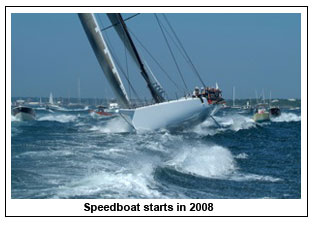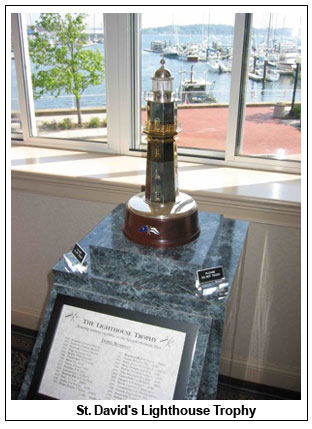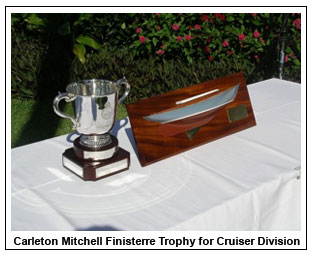|
Weather a likely decider in this year's Bermuda Race
By John Rousmaniere
 Everybody’s getting a little tense as the start of the 47th Newport Bermuda Race approaches. After months of preparation, crews are stowing gear and testing sails, boats with cooks are sending expeditions to supermarkets, boats without cooks worry about tardy deliveries of freeze-dried food, and the race headquarters (the New York Yacht Club’s Sailing Center) is filled with officials and sailors registering their boats and filing forms with Bermuda’s immigration officials.
Everybody’s getting a little tense as the start of the 47th Newport Bermuda Race approaches. After months of preparation, crews are stowing gear and testing sails, boats with cooks are sending expeditions to supermarkets, boats without cooks worry about tardy deliveries of freeze-dried food, and the race headquarters (the New York Yacht Club’s Sailing Center) is filled with officials and sailors registering their boats and filing forms with Bermuda’s immigration officials.
All that seems inconsequential compared with what Karl Kwok’s 80-footer Beau Geste has to do. On June 11 (last Friday) she started the race from Annapolis to Bermuda. She finished on the 14th (setting a new course record), hove-to long enough to take aboard 24 pizzas, and then headed north toward Newport for her second Bermuda Race, starting June 18.
Navigators and tacticians, meanwhile, are hunched over their computers and trying to get a sense of race conditions. On Tuesday afternoon it looked as though the start will be in a healthy sea breeze. “Everybody should blast out of here on an upwind leg,” predicted Bjorn Johnson, chairman of the Bermuda Race Organizing Committee. But after a few hours of this, there’s a good chance that the fleet will sail into a big high and wrestle with light westerlies. At least there’s a 200-mile finger of favorable current parallel the rhumb line.
 If the fleet holds steady at 188 boats, this will be the third largest race in the 104-year, 46-race history of the Thrash to the Onion Patch, after the 265-boat turnout in 2006 and 198 in 2008. The only other time there were more than 180 entries was 2002. That turned out to be one of the wildest races in race history, with another long finger of favorable current kicking up a brutal sea and pushing Roy Disney’s Pyewacket to a new elapsed time record for fixed-keel boats of 53 hours, 29 minutes.
If the fleet holds steady at 188 boats, this will be the third largest race in the 104-year, 46-race history of the Thrash to the Onion Patch, after the 265-boat turnout in 2006 and 198 in 2008. The only other time there were more than 180 entries was 2002. That turned out to be one of the wildest races in race history, with another long finger of favorable current kicking up a brutal sea and pushing Roy Disney’s Pyewacket to a new elapsed time record for fixed-keel boats of 53 hours, 29 minutes.
If the wind comes up, this year’s race could also be one for the big boats. The 99-foot Speedboat or 90-foot Rambler would have a shot at a new course record. Behind them would be a pack of 60- to 70-footers like Bella Mente, which cleaned up at the New York Yacht Club Annual Regatta last weekend, or the English Rán, which last year won the 2009 Rolex Fastnet Race and took Class 1 in the Rolex Sydney-Hobart. Also in this group is Sir Geoffrey Mulcahy’s Noonmark VI, on an extended circumnavigation to compete in the world’s major races. A sentimental favorite is Zwerver, a 56-foot wooden sloop with an eight-foot tiller that Olin Stephens (a member of the Bermuda Race Role of Honour) designed for a Dutch sailor in the 1950s.
If the wind is light, this should be a comfortable race. One crew has announced that they hope to spend the off watches doing yoga and watching movies. If the going is that placid, this should be a small-boat race, and all eyes will be on Peter Rebovich’s Sinn Fein, going for a remarkable third straight win in the 104-boat St. David’s Lighthouse Division. One of her challengers will be a sistership Cal 40, Bill LeRoy’s Gone with the Wind, which has been shipped east from San Francisco Bay. St. David’s is one of a pair of the race’s divisions (five in all) that’s experienced a significant change in size, it its case downward from 122 to 104 boats “That’s probably due to the economy,” says Bjorn Johnson. “But the big news about St. David’s is that there are many more first-timers than usual. Typically, a little over 20 percent of the boats are sailing their first Bermuda Race. This year it’s 30 percent.”
The Double-Handed Division has also changed size, it its case moving upward with 23 competitors, almost double the 12 starters in the 2008 race. If that number holds, the division will sail in two classes, with lighter, race-oriented boats in one and cruiser-racers in the other. Johnson, himself a double-handed sailor, says these boats are becoming popular for several reasons. “First, it’s a family boat. Some crews are two friends, but more couples are beginning to race together now. And these boats are so much simpler to sail than they used to be, what with GPS, good autopilots, spinnaker socks, and everything else that makes them easy to use.”
 There’s one more advantage to double-handers, says Johnson: “With fewer people there’s much more room. Think of it, when I go off watch I’ll have my own private stateroom!”
There’s one more advantage to double-handers, says Johnson: “With fewer people there’s much more room. Think of it, when I go off watch I’ll have my own private stateroom!”
That’s one of the race’s many special features. Whatever the conditions, light or heavy or in between, most crews would consider themselves extremely lucky to be in the running for one of the division prizes that will be handed out on June 26 at the spectacular prize-giving ceremony at Government House (the home of the island’s Governor, appointed by Queen Elizabeth). There are the Lighthouse trophies for the St. David’s (amateur crews) and Gibbs Hill (professional crews) Divisions, the Carleton Mitchell Finisterre Trophy for the Cruiser Division, the Moxie and Weld trophies in Double-Handed, The Royal Mail Trophy for the Open Division for cant keelers, and the North Rock Beacon Trophy for top boat under the IRC Rule.
There are many other prizes – some for navigators, the William L. Glenn Family Participation Prize for the top crew that includes at least four members of the same family, and (the race’s oldest prize) the Galley Slave Trophy, which one goes to the cook of the last boat to finish and is awarded with the sympathy of anyone who has ever had to cook at sea in small boat for days at a time. When the first boat on elapsed time crosses the finish line off St. David’s Lighthouse, by long tradition the commodores of the two sponsoring clubs, the Cruising Club of America and the Royal Bermuda Yacht Club, are always on hand to present Champagne and a case of beer.
And then there are the races within the race. Morris Yachts will present a prize to the top-finishing boat built by the Down East yard. The J-44 class will award a new prize in memory of longtime Gold Digger navigator John Bonds. Important facts about the Newport Bermuda Race:
Founded in 1906, the biennial Newport Bermuda Race is the oldest regularly schedule ocean race, and the inspiration of the Fastnet, the Sydney-Hobart, the Port Huron-Mackinac, and other races. Since 1926 the race has been run jointly by the Cruising Club of America and the Royal Bermuda Yacht Club through the Bermuda Race Organizing Committee.
In 46 races, there have been 4,677 boats with approximately 49,000 sailors who have raced approximately 3,000,000 miles. Two boats have been lost, and one life (in a fire in 1932).
The race inspires remarkable loyalty among thousands of sailors who have raced 635 miles across blue water since the first “thrash to the Onion Patch.” More than 50 sailors have competed in at least 15 races. Some have done more than 20.
Because the race is almost entirely out of sight of land and crosses the often stormy Gulf Stream, every boat must pass a rigorous inspection. The Bermuda Race is called “the thrash to the Onion Patch” because most include some closehauled sailing across the Gulf Stream in rough water (what sailors call “a hard thrash”), and until the twentieth century, Bermuda was an agricultural island where large onions thrived. Every Bermuda sailor is by definition a Thrashee.
TOP
|